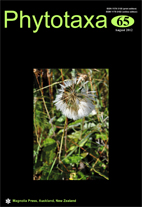Abstract
Nardia huerlimannii has always been an alien element in Nardia Carrington (1870). Schuster (2002) proposed a new subgenus for this species, but the morphological and ecological differences are large enough to separate it from Nardia as an independent genus. Maximally incrassate cells of the stem, 1–2 cells rows (merophytes) leaf-free dorsally, stellate leaf cells with very conspicuous middle lamellae, very coarse trigones, conspicuously papillose cell surface (cells looks to be coarsely elevated) etc. are characteristics not known in any other species of the genus Nardia. Moreover, the species is corticolous, and all other known Nardia species are terricolous or saxicolous. Unfortunately this species is known only from sterile material and it has not yet been included in any molecular study so the correct family placement is not known.

